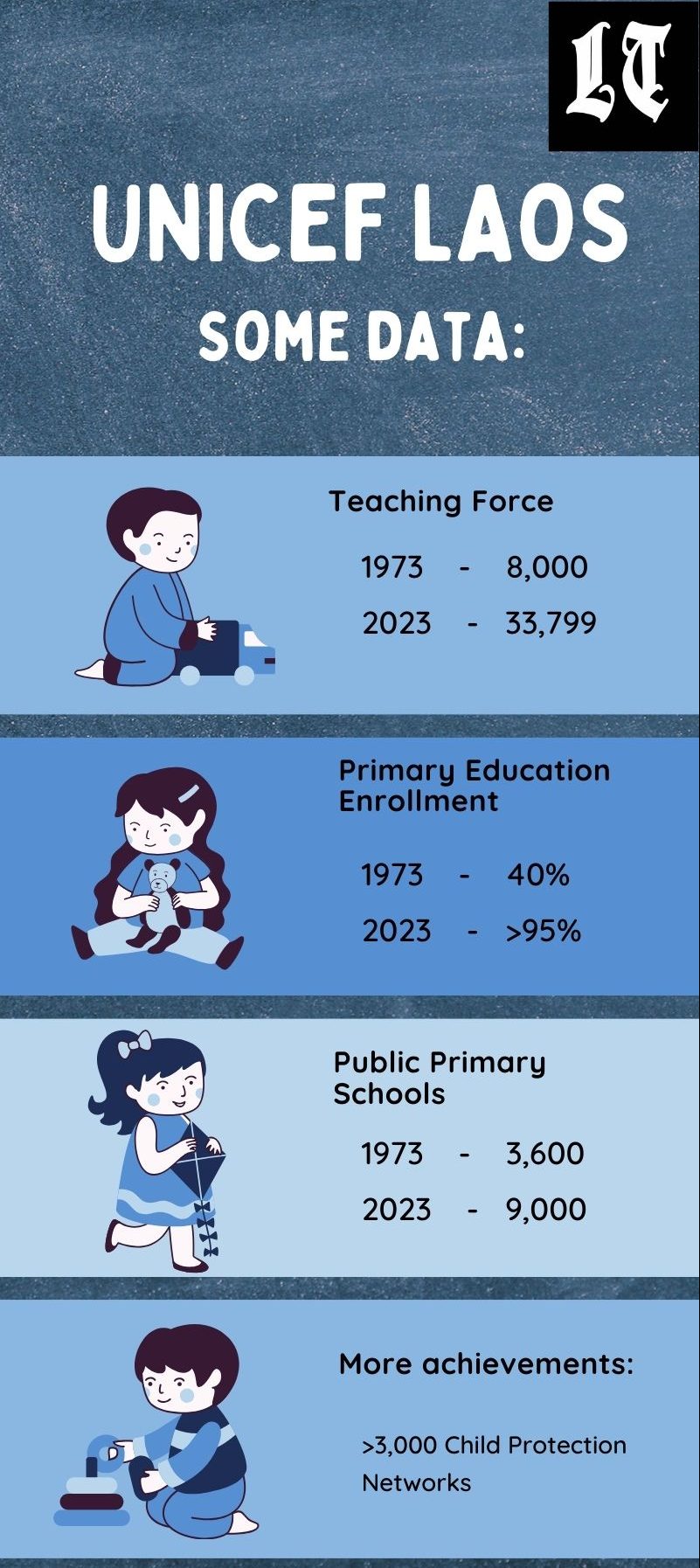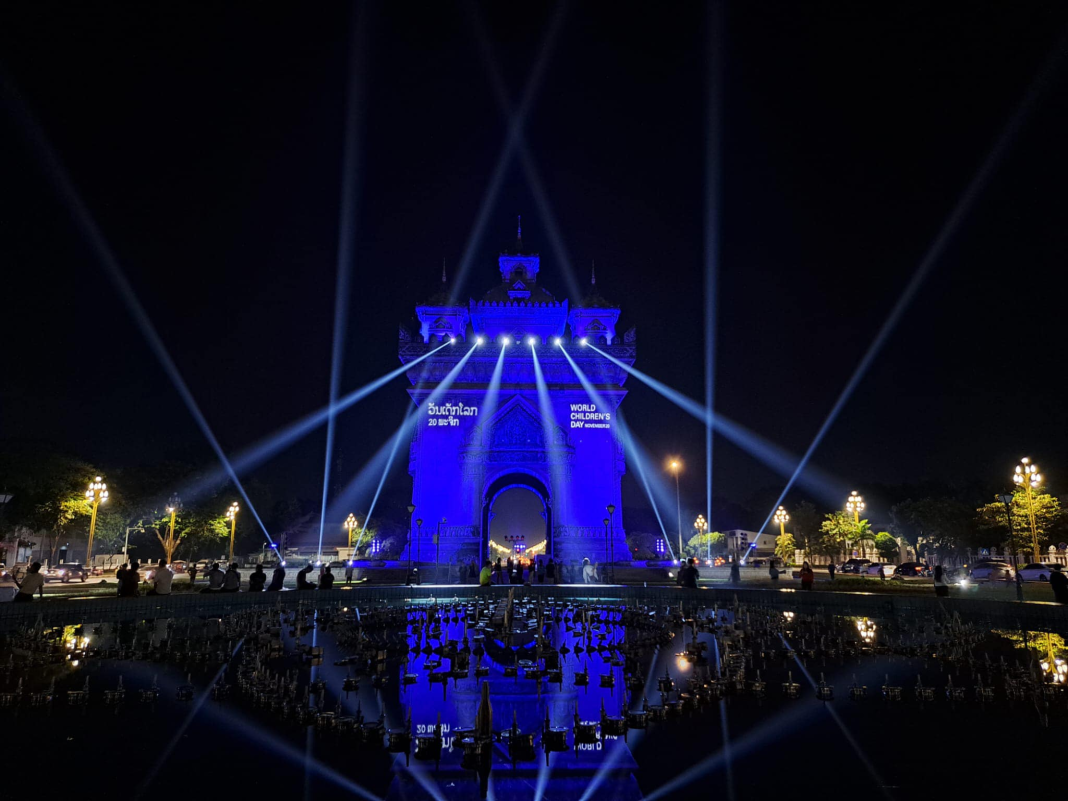It was 1973, and the peace agreement between the Royal Lao Government and the communist Pathet Lao marked the end of the Lao civil war and set the stage for the United Nations International Children’s Emergency Fund (UNICEF) to step into Laos.
Half a century later, their story is still unfolding in a tale of dedication, progress, and hope for children across Laos.
On a sunny day in the early 2000s, current UNICEF Lao Representative Dr. Pia Rebello Britto arrived in a remote village for ethnolinguistic discussions with local families as a part of her research program with Yale University. What she found was a group of mothers and their children sitting on the village square floor under the scorching sun, sharing their aspirations through two translators bridging English, Lao, and ethnic languages.
“A young mother stood up, holding her baby girl, and told us she wanted her child to have a job like mine—traveling the world and speaking many languages,” Britto said. “This poignant moment resonated deeply. It revealed a universal aspiration to equal opportunities.”
Despite the challenging circumstances and the inherent inequality faced by newborns in remote villages, the mother’s dream for her child was rooted in equality, Britto recounted.
“This realization left a lasting impact on me. It led me to consider UNICEF as a crucial platform and voice to work towards creating equal opportunities,” she said.
“The memory of that young mother’s powerful aspiration continues to guide my commitment to promoting equity and bridging gaps, especially for those who start life with unequal advantages.”
Twenty years later, Britto continues to believe in equality and basic rights for all children as she helms UNICEF in Laos.
To celebrate 50 years of achievements in children’s rights, the UNICEF office illuminated Vientiane’s iconic Patouxay monument in blue on 20 November 2023, World Children’s Day. The symbolic gesture emphasized the organization’s commitment to the well-being of every child in Laos.
Through extensive collaboration with local governments, the organization has undoubtedly influenced positive change. But the focus now shifts to understanding the tangible transformations witnessed during this period and the concrete advancements achieved for Lao children—how their present realities starkly differ from those of their grandparents half a century ago.
50 Years of Achievements in Child Education, Health, and Well-being in a Journey to Excellence
Five decades on, Laos has not only excelled in achieving universal primary education, making it one of the nations that successfully met the Millennium Development Goals, but also boasts a triumph in the substantial reduction of stunting rates, showcasing a significant improvement in the well-being of its children.
But that’s not all. These past years of collaborative effort between local government and international children’s rights organizations have also led to the creation of a more inclusive platform for the youth to voice their opinions.
Reflecting on the nearly two-decade-old youth media program, Britto believes it now stands as a monumental achievement in providing young people with a space to express themselves and bring attention to issues that matter to them. While it may not be quantifiable in terms of numbers, the impact is generational—a legacy that extends beyond mere statistics.
“When we delve into the realm of youth media, we see so many stories of transformation and empowerment. Many people who were once part of this program have transitioned into adulthood, now working as journalists for television,” Britto said. “Witnessing this evolution is heartening. They’ve really found a way to express themselves.”
 Navigating Modern Challenges in Laos and Beyond
Navigating Modern Challenges in Laos and Beyond
However, despite these achievements, modern challenges such as ongoing wars, climate change, the COVID-19 pandemic, and economic crises have taken a toll on children’s rights across the world, and Laos is no exception.
“I think the whole world is facing a similar set of challenges now with the whole Polio crisis, because everywhere we look in the news, the situation for children is really like childhood is under threat,” Britto said. “It’s really the children who are under threat because of the macroeconomic instability in most countries. Governments are prioritizing different things, and when you start losing the prioritization for children, then you start losing the investments you need in the social sector, like in health, in education, in things that matter for children’s development. Also, I think the climate issue is a massive challenge. I think we have to tackle it head-on.”
The deficiencies in infrastructure and accessibility, especially in rural areas, contribute to widespread deprivation, as pointed out by Britto. A notable decline in indicators for children’s basic rights is evident, emphasizing the urgent need to address these issues to create a more equitable and inclusive environment. Examining the indicators for children’s basic rights in the country, a notable decline becomes evident for those living in rural areas due to their limited access to essential services. Additionally, a significant factor contributing to this decline is the limited access to education, especially for children whose mothers possess low levels of literacy.
These various factors cumulatively result in widespread deprivation. According to Britto, 70 percent of children in Laos experience two or more significant deprivations, with 50 percent facing three or more, including basic health and hygiene. This staggering statistic highlights the pervasive nature of unmet basic needs among a substantial portion of the child population.
The challenge extends beyond income disparities, encompassing a broader spectrum of deprivations that affect the well-being of children. Addressing these issues is crucial for creating a more equitable and inclusive environment for all children in Laos, as Britto highlighted.
Bridging the Gap Between Theory and Practice in Children’s Rights in Laos
But how to address the practical implementation of what is often the subject of a broad theoretical dialogue—children’s rights—often arises as a critical question.
“I think our work is all ‘boots on the ground,’ and yeah, that’s what we’re doing well. So I would say the most notable practical work we have is supporting the government to deliver basic services for every child,” Britto said.
This encompasses education, healthcare, protection, and access to clean water, all regarded as integral components of government responsibilities rather than isolated projects, she explained. “Even during the pandemic-induced closure of schools, UNICEF collaborated with the government to establish Laos’ first-ever digital teaching and learning platform. The overarching goal remains to uphold children’s rights by supporting the government in creating an environment that safeguards their well-being.”
The emphasis lies in fortifying the government’s capacity through robust laws, rights protection, well-trained staff, and adequate services, ensuring quality education with trained teachers, accessible textbooks, and functional classrooms, for instance. Meanwhile, health initiatives include vaccination programs and counseling services.
As UNICEF in Laos celebrates its 50th anniversary, the journey of hope and progress continues. The collaboration between UNICEF, the Lao government, and various stakeholders serves as a testament to what can be achieved when dedication and resources are directed toward the betterment of society. The 50th anniversary is not just a time for reflection but also a moment to envision a future where every child in Laos can fulfill their potential—a legacy of hope and resilience for generations to come.



